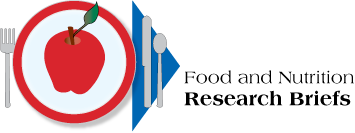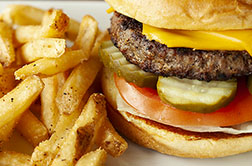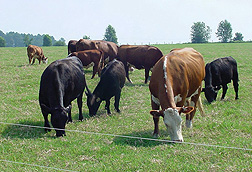
| January 2020 |
Humans More Unique than Expected When It Comes to Digesting Fatty MealsPeople have very individualized inflammatory responses to eating a high-fat meal. These were the somewhat unexpected results of a study published in the Journal of Nutritional Biochemistry by researchers at the Agricultural Research Service and their University of California-Davis colleagues. Inflammatory reactions of 20 volunteers were measured at 0, 3 and 6 hours after eating a standardized meal containing 38 percent fat. The volunteers' responses were completely unique. Each volunteer had both a unique amount of inflammatory response and a unique amount of time for when the responses peaked, up to 6 hours after eating. Scientific contact: Danielle Lemay, (530) 752-4748, Western Human Nutrition Research Center, Davis California. |
|
World's First True Red Spinach Variety ReleasedUSDA Red, the world's first true red spinach variety has been released by the Agricultural Research Service. Spinach has always been known as a green leafy vegetable. There are leafy vegetables often called red spinach,But these are actually red-leaf amaranths (Amaranthus spp.) or other plants such as Red Goosefoot (Blitum rubrum), not true spinach (Spinacia oleracea). There are currently some true ''red'' spinaches on the market, but the red color is limited to the veins of the leaves. USDA Red is the real thing: a red leafed true spinach. The antioxidant capacity of USDA Red was 42–53 percent higher than other spinach cultivars in five tests conducted over three years. The red color of USDA Red comes from the phytonutrient betacyanin rather than the more common anthocyanin. Betacyanin is a potent antioxidant. Scientific contact: Beiquan Mou, (831) 755-2893, Crop Improvement and Protection Research Unit, Salinas, California. |
|
ARS Efforts Should Help Ensure Our Wheat SupplyARS researchers and their colleagues have identified a key gene that could be used as an important genetic resource by wheat breeders worldwide to address the constant challenge posed by Fusarium head blight (FHB). FHB, also known as "scab," thrives in warm and moist conditions and is becoming an increasing threat worldwide because of the unpredictable weather patterns brought on by climate change and an increasing trend toward more corn production and no-till farming, which both increase the availability of the pathogen in fields. The gene, known as TaHRC, plays a key role in conferring resistance to FHB. The findings may be applied to breeding improved varieties of wheat. Scientific contact: Guihua Bai, (785) 532-1124, Hard Winter Wheat Genetics Research Unit, Manhattan, Kansas. |
|
Innovative Cornstarch Makes Products Sustainable and 'Green'An ARS research group has used steam-jet cooking and other processing methods to create a starch-vegetable-oil-based complex with a variety of useful properties. For example, by combining cornstarch with vegetable oil, the team created a stabilizer to be used in salad dressings, sauces, ice cream and other foods or beverages, as well as industrial products like paints, glues and cleaners. This stabilizer combines high-amylose starch with salts of fatty acids derived from vegetable oil fatty acids—rather than petroleum oil—producing emulsifiers, polymer films and coatings that could open the door to new products that leave behind a smaller environmental "footprint." Scientific contact: Gordon Selling, (309) 681-6338, Plant Polymer Research Unit, National Center for Agricultural Utilization Research, Peoria, Illinois. |
|
Dr. Alfonso Clavijo Named Director of USDA National Bio and Agro-Defense FacilityAlfonso Clavijo has been appointed as Director of the National Bio and Agro-Defense Facility (NBAF), a state-of-the-art USDA research and diagnostic facility designed to protect the nation's agricultural systems and stakeholders against the threat and potential impact of serious animal diseases. ARS partners with USDA's Animal and Plant Health Inspection Service to operate NBAF. The facility is currently under construction by the U.S. Department of Homeland Security (DHS) with commissioning scheduled for 2021. Clavijo, who started Oct. 13, 2019 will play a key role in ensuring the smooth transition of responsibility from DHS to USDA once the 574,000 square-foot facility becomes fully operational in 2023. Scientific contact: Alfonso Clavijo, (785) 477-9006, National Bio and Agro-Defense Facility, Manhattan, Kansas. |
|
A New ARS Strawberry is a 'Keepsake'A new strawberry cultivar, Keepsake, was released by ARS. 'Keepsake' is a midseason, spring-bearing, or short-day strawberry (Fragaria xananassa Duch ex Rozier). The new strawberry is the first resulting from an increased effort by ARS to develop strawberries with improved shelf life. Compared with other current strawberry cultivars and breeding selections evaluated after 2 weeks in cold storage, 'Keepsake' had a low proportion of degraded and decayed fruits. The proportion of fruits degraded at one week was 29 percent lower than for all the other cultivars, including Chandler (81 percent) and Camarosa (93 percent). These fruits have outstanding flavor with very high soluble solids (sweetness) and moderate acidity (tartness). They also have a pleasing texture and are juicy when eaten. Scientific contact: Kim Lewers, (301) 504-6768, Genetic Improvement of Fruits and Vegetables Laboratory, Beltsville Agricultural Research Center, Beltsville, Maryland. |
|






